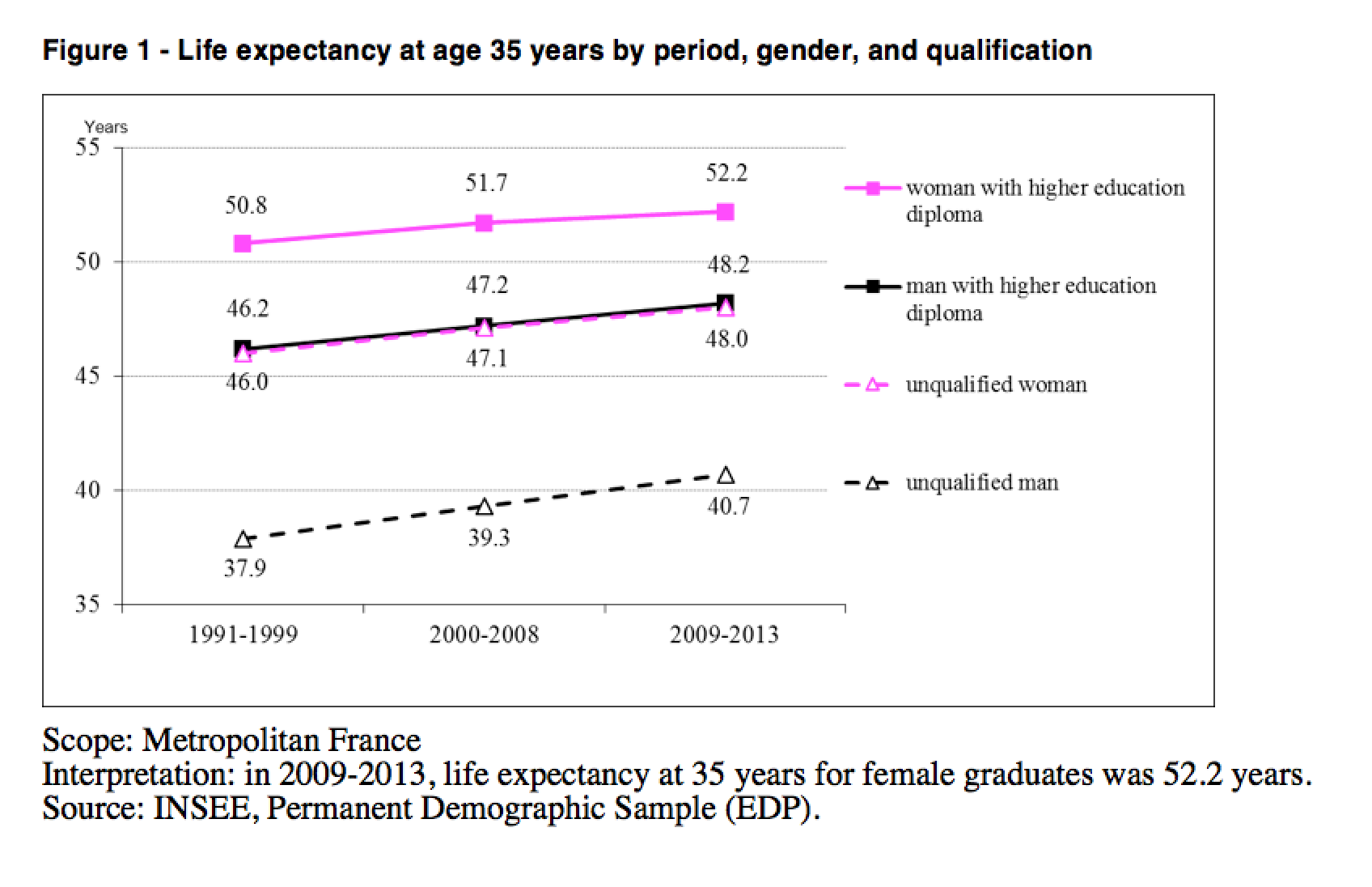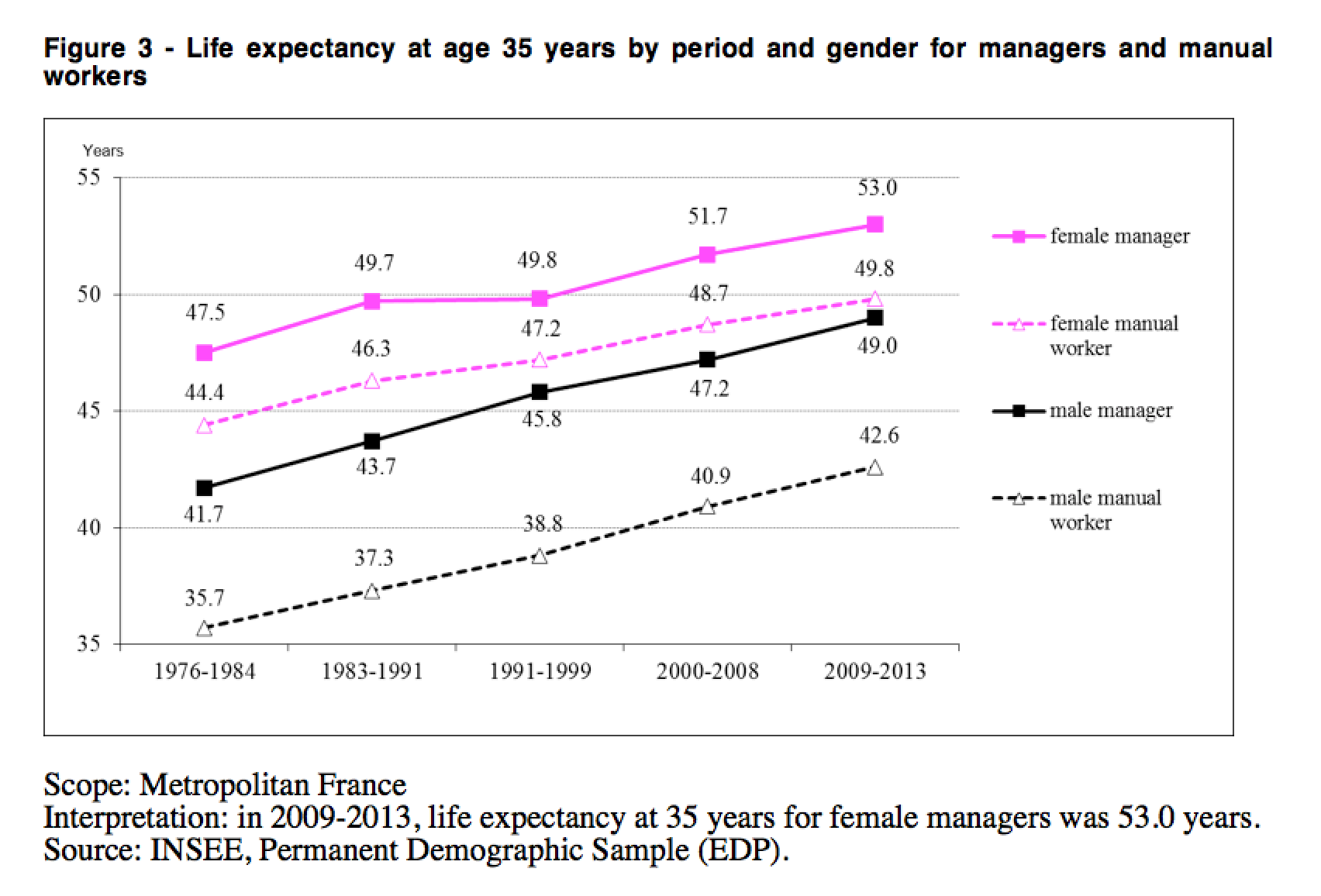We all die one day, but we are not all equal in this respect, because death tends to strike at different ages. Take men and women, for instance: in France, under the mortality conditions of 2009-2013,
at the age of 35 a woman could expect to live another 50.5 years on average and a man only 44.5 years, six years less. Life expectancy differs not only by gender, but also by social category. The gap between the life expectancy of managers and that of manual workers is 6.4 years for men and 3.2 years for women (Blanpain, 2016). Life expectancy disparities are a clear illustration of social differences, but these figures are averages that do not pinpoint the risk of early death. Another way of presenting these differences is as follows: 18% of male manual workers aged 35 years subjected to the mortality conditions of 2009-2013 would die before the age of 65, versus just 7% of managers. Women appear to fare better: 8% of female manual workers subjected to the same conditions would die before 65, compared to 4% of female managers.
The nature of one’s occupation explains only a part of these differences. Managers are, of course, less subject to occupational hazards than manual workers. In addition, they belong to a social group whose lifestyle is favourable to good health: risky health behaviours, use of healthcare and obesity are less common among managers than manual workers. Lastly, state of health itself can have an influence on social category: failing health may oblige people to curtail their education or leave the labour force, or make it more difficult for them to get promotion or access more qualified jobs during their career.
A man with a degree lives 7.5 years longer than an unqualified man
The gap in life expectancy between graduates and people with no qualifications is greater among men (7.5 years) than women (4.2 years; Figure 1). Among men, life expectancy differs considerably according to the level of qualification reached, and an extra qualification is associated with a gain in life expectancy. Thus at 35, a male graduate can expect to live on average 1.8 years longer than a man who left education with a high-school diploma; 3.5 years more than a man with a high-school vocational diploma; 4.6 years more than a man with only the basic school leaving certificate and 7.5 years longer than a man with no qualifications at all (Figure 2).
Among women, there are pronounced disparities in life expectancy between the most and the least qualified. However, among those with qualifications, the differences in life expectancy are not very marked by level of qualification. A female graduate lives, on average, almost as long as a woman with a high-school diploma (gap of 0.4 years), and the difference with respect to women with a high school vocational diploma (1.0 year) or the basic school leaving certificate (1.7 years) is not that large. However, she will live substantially longer than a woman with no qualifications (4.2 years).
Female manual workers live a little longer than male managers
When it comes to death, it is better to be a woman, a graduate or a manager. These differences are well known. More surprising is that the life expectancy of French women is higher than or equal to that of men, whatever their level of qualification or social category. Thus, female manual workers, who are the active women with the lowest life expectancy, live on average almost a year longer than male managers. In addition, the life expectancy of unqualified women is virtually the same as that of men with the highest education qualification. And yet, female manual workers and women with no qualifications have a number of characteristics unfavourable to their health: their income is lower than that of male managers and their working conditions are generally more arduous. On the other hand, some of their behaviours are more favourable to their health. According to the 2008 Disability and Health survey, female manual workers consume less alcohol than male managers at every age. In addition, they benefit from better medical surveillance, in particular during their fertile years. Furthermore, their working time (working week or throughout life) is shorter, thereby reducing their risk of exposure to occupational hazards. Finally, women are thought to have biological advantages that partly explain their longer life expectancy (Vallin, 2002).
The gender gaps in life expectancy have been narrowing since the mid-1990s. This is the case in particular for the gap between male managers and female manual workers. In fact, certain male and female behaviours have converged. For example, according to the 2008 Disability and Health survey, female manual workers aged under 60 smoke more than male managers, whereas this was not the case in previous generations.
Unchanged social inequalities in survival chances since the late 1970s
Since the end of the Second World War, life expectancy has increased virtually without interruption in France. In particular, men aged 35 years have gained 6.7 years of life expectancy since the end of the 1970s and women 5.5 years. The fall in mortality has benefited all social categories to more or less the same extent: active men have gained 6 to 7 years depending on their social category, and women 5 to 6 years.
However, disparities between the life expectancy of different social categories have persisted. Thus in 2009-2013, the difference in life expectancy between a 35-year old manual worker and a manager of the same age was 6.4 years for men and 3.2 years for women. Since the end of the 1970s, this gap has been close to 6.5 years for men and 3.0 years for women (Figure 3). Likewise, the gap between intermediate professions and manual workers has stayed about the same since that time, approximately 4.5 years for men and 2.0 years for women.
Bibliography
Blanpain N., 2016, Les cadres vivent toujours 6 ans de plus que les ouvriers, Insee Première, no. 1584.
Vallin J., 2002, Mortalité, sexe et genre, in Caselli G., Wunsch G., Vallin J. (ed.), Démographie : analyse et synthèse. III. Les déterminants de la mortalité, p. 319-350, Paris, INED. [English version: 2005 Mortality, sex and gender, chapter 53 in Caselli G., Wunsch G., Vallin J. (eds.), Demography, Analysis and Synthesis. A Treatise in Population, Elsevier/Academic Press, p. 177-194.]





